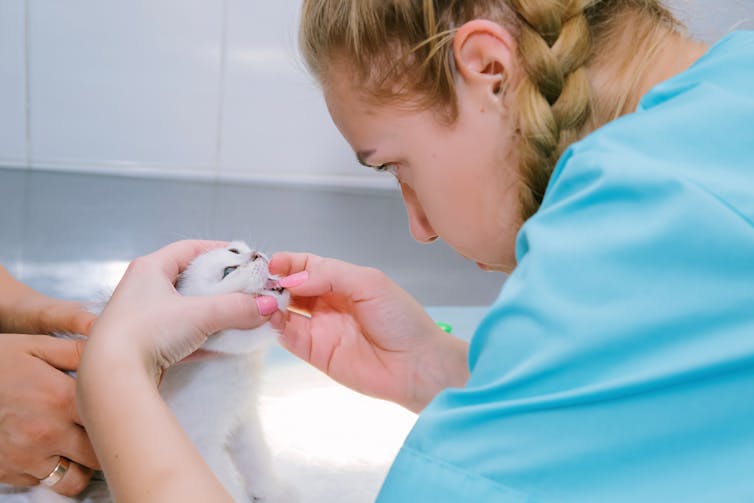Source: The Conversation (Au and NZ) – By Michelle Circelli, Senior Research Officer, National Centre for Vocational Education Research (NCVER)

This article is part of a series providing school students with evidence-based advice for choosing subjects in their senior years.
Vocational education and training, or VET, is where you learn skills for employment. Think of plumbers, veterinary nurses, fashion designers, make-up artists, chefs, childcare workers, furniture makers, shipbuilders, carpenters, builders, electricians, laboratory and cybersecurity technicians, surveyors, legal assistants and many other vocations.
VET is done in secondary schools and post-school educational organisations such as TAFEs or private training institutions. It’s also provided in workplaces and in the community.
It can be done at your own pace, with a group through online learning, in the classroom, or a combination of these. If you’re thinking of doing a VET subject in the senior years at school, here’s what you need to know.
What kinds of VET qualifications are there?
Secondary school students can enrol in nationally recognised VET together with other school subjects. This includes doing school-based apprenticeships or traineeships.
Provided students meet necessary requirements, they can finish school with a VET qualification along with their secondary school certificate.

Shutterstock
VET studies at school involve a combination of classroom and work-based learning. School-based apprenticeships and traineeships are a combination of classroom learning and on-the-job training under a contract of training with an employer.
In 2020, 241,200 secondary school students across Australia were doing VET that contributed to their senior secondary school certificate. This was an increase of around 2% on the previous year. More males did a VET course than females.
Read more:
We need to change negative views of the jobs VET serves to make it a good post-school option
If you want to do a school-based apprenticeship or traineeship you need to have an employer willing to employ you. In 2020 around 7% (17,800) of secondary students doing VET decided on this pathway. Queensland had the highest proportion of school-based apprentices and trainees of all states and territories.
The top five qualifications done by school-based apprentices and trainees in 2020 were in business, retail, hospitality, childcare, and sport and recreation. Nearly half of all students doing a school-based apprenticeship or traineeship in 2020 enrolled in one of these qualifications.
Most secondary students who do VET don’t do a school-based apprenticeship or traineeship. They do other types of VET studies instead. The top five enrolments in 2020 included qualifications in hospitality, business and construction.
The Certificate II in Skills for Work and Vocational Pathways, a general qualification that helps prepare people for entry into the workforce and/or further vocational training, had the second highest number of enrolments.
Depending on the VET course, students can learn at school, in purpose-built facilities like a trade training centre, or at the premises of an external training provider such as a TAFE or other VET institution.
Schools may also join with other schools in a cluster arrangement to increase what students have on offer. If your school does not have a course you are interested in you can check if you could do it through another school.
It’s a flexible pathway to work and further study
VET is a competency-based system, which means the focus is on the development of a skill. Students then get the opportunity to demonstrate they can perform that skill. It doesn’t matter how the person goes in comparison with others — it only matters how they perform against the standard required.
The VET system provides flexible pathways, enabling students to move in and out of education and training to get the skills and qualifications they need to enter the jobs market. This includes starting their own business, moving through jobs or transitioning to new or related jobs and courses.

Shutterstock
In 2019, there were 4.2 million people — almost a quarter (23.4%) of the Australian resident population aged 15-64 — enrolled in nationally recognised VET courses.
Participation is highest among younger people: 43.2% of 15-19 year olds and 32.2% of 20-24 year olds did some VET in 2019. Some students enrolled in qualifications (such as the Certificate II in Automotive Vocational Preparation or a Certificate III in Electrotechnology Electrician). Others enrolled in short courses such as the Course in First Aid Management of Anaphylaxis or the Course in Asbestos Awareness. Others enrolled just in a single subject, such as learning how to provide cardiopulmonary resuscitation (CPR) or the responsible serving of alcohol.
The number of students enrolled in short courses and stand-alone subjects has increased steadily over the past several years.
Why do students do VET?
Secondary students do VET studies for a range of reasons including to get a qualification while still at school.
Around 45% of secondary students do VET for employment reasons, while 30% do it for further study. About a quarter of secondary students do VET for personal development.
Doing a VET course while at school can help in getting a job directly after you finish school. Research has found students who did VET studies at school, including school-based apprenticeships and traineeships, were more likely than those who didn’t to be in full-time and permanent employment five years after their studies.
Read more:
Most young people who do VET after school are in full-time work by the age of 25
In the states and territories that allow it, many students do VET studies that count toward their ATAR. Some 45.2% of students in secondary schools that do VET also get an ATAR.

Shutterstock
Research has also explored the intended occupation of students doing VET in secondary school and whether they actually get that job. The strongest links were in trade-related study areas — electrotechnology and telecommunications, construction trades, and automotive and engineering trades. There were also strong links across other occupational groups, like sales assistants, and carers and aides.
Will I earn less money than if I go to uni?
The most common post-school qualifications for secondary students who did VET studies were VET qualifications. But almost 20% of students had also gone on to complete a bachelor’s degree.
People with university qualifications generally earn more per week than people with VET qualifications. But this masks the variability in wages between industries and jobs that require VET qualifications.
For example, people who have a VET qualification and work in the agricultural, forestry and fishing, or mining industries have similar, if not higher, weekly earnings as those who have a university qualification.
Read more:
Choosing your senior school subjects doesn’t have to be scary. Here are 6 things to keep in mind
Technicians and trades workers (such as plumbers, information communications technology support technicians, operating theatre technicians) who have VET qualifications earn as much per week, if not more, than those with university qualifications in a similar job.
You can’t go wrong doing VET studies at school. It sets you up for a job straight after school as well opening up opportunities to do further study, whether that be more VET or a uni degree.
Read the other articles in our series on choosing senior subjects, here.
![]()
The authors do not work for, consult, own shares in or receive funding from any company or organisation that would benefit from this article, and have disclosed no relevant affiliations beyond their academic appointment.
– ref. Doing a VET subject in years 11 and 12 can help with a job and uni. Here’s what you need to know about VET in the senior years – https://theconversation.com/doing-a-vet-subject-in-years-11-and-12-can-help-with-a-job-and-uni-heres-what-you-need-to-know-about-vet-in-the-senior-years-165798







